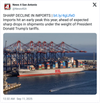Shipping
August Ocean Freight Report: Early Bookings, Tariff Risks, and Carrier Capacity Controls
Global shipping markets face a late-summer mix of tight space, tariff uncertainty, and inland transport pressures.
Global shipping markets are entering late summer with a mix of steady demand, targeted capacity cuts, and mounting tariff uncertainty. While inland networks in North America remain relatively stable, importers and exporters are weighing booking strategies against the backdrop of evolving trade policies and seasonal shipping pressures.
Ocean Freight Trends and Capacity Management
- Europe to North America – Recent U.S. tariff announcements have introduced uncertainty for fall shipments. While maintaining current routing may feel familiar, logistics planners are reviewing capacity options now to avoid disruptions if policies shift.
- Indian Subcontinent, Middle East, and Africa to North America – The Red Sea region remains a challenge. Peak season volumes are expected to tighten space on the Middle East–Colombo Loop and Trans Pacific 16 route (along the Panama Canal), prompting early booking advisories. West Coast rerouting may offer temporary relief, though space will also be constrained by early fall.
- Asia-Pacific to North America – Transpacific volumes have softened, with the Shanghai Containerized Freight Index showing declines into both U.S. coasts.
GreenWorldwide reports Transpacific service utilization has slipped to the mid-80% range, the lowest since spring. Carriers are responding with blank sailings and reduced rotations to protect load factors. Analysts expect a possible late-September rebound tied to China’s Golden Week pause, though any spike may be short-lived.
Tariff Pressures Shape Shipping Decisions
Bookings have slowed since mid-July as importers wait for tariff clarity. The August 7 reciprocal tariffs are set to impact smaller shippers and low-value cargo disproportionately, with some companies delaying orders until duties stabilize.
A recent Executive Order under IEEPA adds a 25% duty on articles of Indian origin imported from the Russian Federation—including petroleum and derivatives, effective August 27, supplementing existing tariff measures.
Inland Transport Conditions
Maersk reports inland operations across the U.S. are meeting performance expectations, with low container dwell times, quick truck turns, minimal rail delays, and solid chassis availability. However:
- Priority equipment is being directed to tariff-sensitive cargo, potentially delaying lower-priority moves.
- Carrier bankruptcies have added pressure to the drayage market.
- Early booking and clear communication of special cargo requirements are recommended.
Source: Maersk | GreenWorldwide
Sign up for FreightCaviar
The only newsletter you need for freight broker news & entertainment.
No spam. Unsubscribe anytime.







